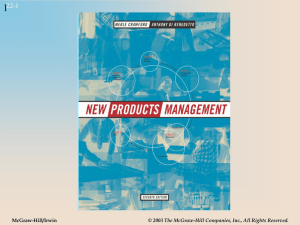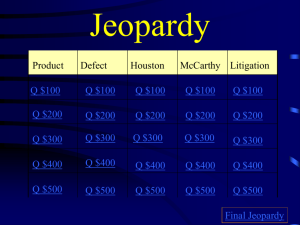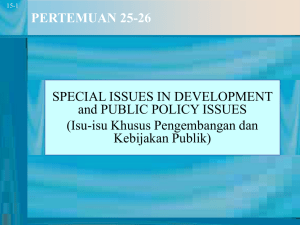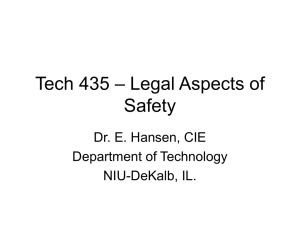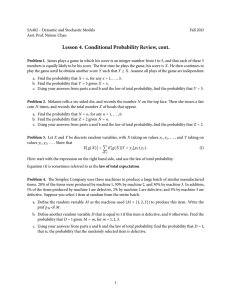Defective Condition - Marquette Law Scholarly Commons
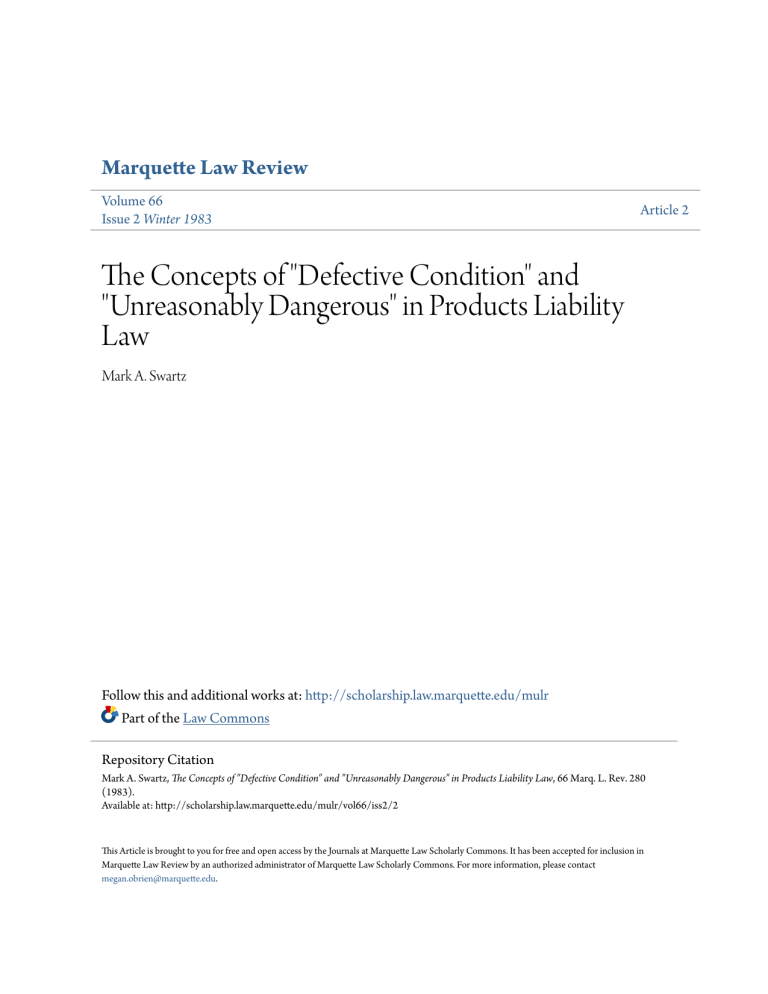
Marquette Law Review
Volume 66
Issue 2 Winter 1983
The Concepts of "Defective Condition" and
"Unreasonably Dangerous" in Products Liability
Law
Mark A. Swartz
Article 2
Follow this and additional works at: http://scholarship.law.marquette.edu/mulr
Part of the Law Commons
Repository Citation
Mark A. Swartz, The Concepts of "Defective Condition" and "Unreasonably Dangerous" in Products Liability Law , 66 Marq. L. Rev. 280
(1983).
Available at: http://scholarship.law.marquette.edu/mulr/vol66/iss2/2
This Article is brought to you for free and open access by the Journals at Marquette Law Scholarly Commons. It has been accepted for inclusion in
Marquette Law Review by an authorized administrator of Marquette Law Scholarly Commons. For more information, please contact megan.obrien@marquette.edu
.
THE CONCEPTS OF "DEFECTIVE
CONDITION" AND "UNREASONABLY
DANGEROUS" IN PRODUCTS
LIABILITY LAW
MARK A. SWARTZ*
I. UNANSWERED QUESTIONS IN THE DIPPEL DECISION
Almost sixteen years after the Wisconsin Supreme
Court's decision in Dippel v. Sciano,' which adopted section
402A of the Restatement (Second) of Torts
2 dealing with strict products liability, questions remain as to what elements must be proved to find liability for harm caused by a product. Wisconsin's decision to abolish the requirement of privity of contract in products liability cases came just four years after California's abandonment of the warranty doctrine in the products area. The Dippel court held that "[flor products liability cases we adopt the rule of strict liability in tort as set forth in Sec. 402A of Restatement, 2 Torts
2d. . .
."
The court then quoted the Restatement (Second)
of Torts section 402A verbatim:
Sec. 402A. Special Liability of Seller of Product for
Physical Harm to User or Consumer.
(1) One who sells any product in a defective condition unreasonably dangerous to the user or consumer or to his property is subject to liability for physical harm thereby
B.A., 1969, Northwestern University; J.D., 1975, Marquette University Law
School. Mr. Swartz is a shareholder in the firm of Samster, Aiken, Peckerman,
Swartz & Mawicke, S.C., Milwaukee, Wisconsin.
The author would like to thank Susan Rosenberg for her assistance in the preparation of the initial draft.
Particular acknowledgement must be made of the assistance of Timothy J. Aiken, also a shareholder in the firm of Samster, Aiken, Peckerman, Swartz & Mawicke,
S.C., Milwaukee, Wisconsin.
1. 37 Wis. 2d 443, 155 N.W.2d 55 (1967).
2. RESTATEMENT (SECOND) OF TORTS § 402A (1965).
3. Greenman v. Yuba Power Prods., Inc., 59 Cal. 2d 57, 377 P.2d 897, 27 Cal.
Rptr. 697 (1962).
4. 37 Wis. 2d at 459, 155 N.W.2d at 63.
19831 PRODUCTS LIABILITY caused to the ultimate user or consumer, or to his property, if
(a) the seller is engaged in the business of selling such a product, and
(b) it is expected to and does reach the user or consumer without substantial change in the condition in which it is sold.
(2) The rule stated in subsection (1) applies although
(a) the seller has exercised all possible care in the preparation and sale of his product, and
(b) the user or consumer has not bought the product from or entered into any contractual relation with the seller.
5
The Restatement section as quoted and adopted by the
Wisconsin Supreme Court did not, however, define two critical terms: "defective condition" and "unreasonably dangerous." Furthermore, the section as quoted did not offer guidance to either the trial bench or the bar upon the question of whether the term "unreasonably dangerous" was in fact a synonym for defective condition or whether the defective condition was itself an additional element of proof.
6
Although it was adopting section 402A verbatim, the court in Dopel v. Sciano served notice that it was not specifically accepting or rejecting any of the comments to that section.
7
These comments, one might assume, would have shed some light upon the issue of whether the plaintiff was required to prove both a defective condition and an unreasonable danger to the consumer. As will be explained below, express adoption of these comments would not have answered the questions posed here. The Doppel v. Sciano decision did, however, list the elements which the plaintiff must prove in a strict products liability case:
From a reading of the plain language of the rule, the plaintiff must prove (1) that the product was in defective condition when it left the possession or control of the seller,
5. Id.
6. Commentators have asserted that the inclusion of both defective condition and unreasonably dangerous in section 402A was the unhappy consequence of the tinkering which occurred in the process of revising section 402A, which had originally been drafted to apply to products generally. See Smith, Status of
gerous" Element in Product Liability Actions, 15 FORUM 706 (1980) (general discussion of strict tort liability for products); Wade, On the Nature of Strict Liabilityfor
Products, 44 Miss. L.J. 825 (1973).
7. 37 Wis. 2d at 459, 155 N.W.2d at 63.
MARQUETTE LAW REVIEW [Vol. 66:280
(2) that it was unreasonably dangerous to the user or consumer, (3) that the defect was a cause (a substantial factor) of the plaintiff's injuries or damages, (4) that the seller engaged in the business of selling such product or, put negatively, that this is not an isolated or infrequent transaction not related to the principal business of the seller, and
(5) that the product was one which the seller expected to and did reach the user or consumer without substantial change in the condition it was when he sold it.'
The requirement that the plaintiff prove both a defective condition and that the product was unreasonably dangerous was imported directly into paragraphs two and five of the
Wisconsin Jury Instruction Civil 3260: "You must be satisfied by the greater weight of credible evidence to a reasonable certainty that: (1) the product was in defective condition; (2) the defective condition made the product unreasonably dangerous to persons or property. .
..
"9
The definitions of defective condition and unreasonably dangerous found in Jury Instruction 3260 were clearly derived from comments g and i of the Restatement (Second) of
Torts section 402A:1
0
A product is said to be defective when it is not reasonably fit for the ordinary purposes for which such product was sold and intended to be used. ....
A defective product is unreasonably dangerous to the user or consumer when it is dangerous to an extent beyond which would be contemplated by the ordinary user (consumer) possessing the knowledge of the product's characteristics which were common to the community.
1 2
II. APPROACHES IN OTHER JURISDICTIONS
Wisconsin was not alone in adopting strict products liability by incorporating section 402A into its common law without comment as to the nature and number of its elements, as if they were somehow self-evident. Illinois did the
8. Id. at 460, 155 N.W.2d at 63.
9. WIS. JURY INSTR. CIVIL 3260 (1971).
10. RESTATEMENT (SECOND) OF TORTS § 402A comments g & i (1965).
11. WIs. JURY INSTR. CIVIL 3260 (1971).
12. Id.
19831 PROD UCTS LIABILITY same in Suvada v. White Motor Co.,13 a case which was cited by the Wisconsin Supreme Court in Dippel v. Sciano.
A. The California Decisions
Nine years after its decision in Greenman v. Yuba Power
Products, Inc.,
15 the California Supreme Court expressly rejected the two-element approach apparently required by the language of section 402A and its comments. In Cronin v.
JB.E Olson Corp., 1 6 the California Supreme Court elected to eliminate the element of unreasonable danger and pro-
7 vide for liability where the product was simply defective.'
The Cronin court decided that to require proof of an unreasonable danger was, in effect, to submit the case to the jury in a posture akin to that of a negligence case. The Cronin court noted that:
Of particular concern is the susceptibility of Restatement section 402A to a literal reading which would require the finder of fact to conclude that the product is, first, defective and, second, unreasonably dangerous .... A bifurcated standard is of necessity more difficult to prove than a unitary one. But merely proclaiming that the phrase "defective condition unreasonably dangerous" requires only a single finding would not purge that phrase of its negligence complexion. We think that a requirement that a plaintiff also prove that the defect made the product "unreasonably dangerous" places upon him a significantly increased burden and represents a step backward in the area pioneered by this court.
8
The committee notes to California's approved jury instructions,
19 which were revised in the wake of Cronin, demonstrate the further difficulties created by a rejection of the unreasonable danger element. Inasmuch as the Restate-
13. 32 Ill. 2d 612, 210 N.E.2d 182 (1965).
14. Dippel v. Sciano, 37 Wis. 2d 443, 456 n.8, 155 N.W.2d 55, 61 n.8.
15. 59 Cal. 2d 57, 377 P.2d 897, 27 Cal. Rptr. 697 (1962).
16. 8 Cal. 3d 121, 501 P.2d 1153, 104 Cal. Rptr. 433 (1972).
17. It is interesting to note that the unreasonably dangerous element was regarded by the Cronin court as having "crept" into California after its inclusion in
§ 402A in 1965, two years after its decision in Greenman. Cronin, 8 Cal. 3d at 129,
501 P.2d at 1159, 104 Cal. Rptr. at 439.
18. Cronin, 8 Cal. 3d at 133, 501 P.2d at 1162, 104 Cal. Rptr. at 442.
19. CAL. JURY INSTR. CIVIL 9.00, at 288-89 (1977 Revision).
MARQ UETTE LAW REVIEW [Vol. 66:280
ment defines defective condition in terms of unreasonable danger, the Restatement itself is of little assistance in redefining strict products liability in relation to defect alone. The committee notes state as follows:
The Restatement definition of a "defective condition" having been disapproved in Cronin v. J.B.E. Olson Corp.
.
. .
.
the court goes on to say that the seller "should be liable for all injuries proximately caused by any of its products which are adjudged 'defective.'" In a footnote to this last statement, the court says, "We recognize, of course, the difficulties inherent in giving content to the defectiveness standard." Unfortunately the court eschewed the opportunity to define either "defect" or "defective condition" within the strict liability rule.
With no decisional or statutory guidance, the Commit-
"defect" or "defective condition."
The California pattern jury instructions adopted subsequent to Cronin are paraphrased as follows: The manufacturer of a product is liable for injuries proximately caused by a defect in design or manufacture which existed when the article left its possession, provided that the injury resulted from a use of the article that was reasonably foreseeable by the manufacturer.
2 1 A defect in the manufacture of a product exists if the product differs from the manufacturer's intended result or if the product differs from apparently
22 identical products from the same manufacturer.
In Barker v. Lull Engineering Co.,23 the California
Supreme Court was confronted with a design defect case wherein the trial court, in spite of the holding in Cronin, in- structed the jury "that strict liability for a defect in design of a product is based on a finding that the product was unreasonably dangerous for its intended use .... -24 Although
the Barker court tacitly conceded that design defect cases are more complex and thus distinguishable from manufacturing defect cases, the above quoted instructions offered by the
20. Id.
21. Id. at 285.
22. CAL. JURY INSTR. CIVIL 9.00.3, at 32-33 (West Supp. 1981).
23. 20 Cal. 3d 413, 573 P.2d 443, 143 Cal. Rptr. 225 (1978).
24. Id. at 417, 573 P.2d at 446, 143 Cal. Rptr. at 228 (quoting Cronin v. J.B.E.
Olson Corp., 8 Cal. 3d 121, 501 P.2d 1153, 104 Cal. Rptr. 433 (1972)).
1983] PRODUCTS LIABILITY trial court were rejected. The Barker decision adopted a dual standard for evaluating design defects: (1) an inquiry into whether the product failed to perform safely in an environment of intended use, and (2) an analysis of risk benefit.
25
A shifting burden of proof was developed in Barker to avoid imposing evidentiary burdens akin to those encountered by plaintiffs in negligence cases. The Barker court noted that
"once the plaintiff makes a prima facie showing that the injury was proximately caused by the product's design, the burden should appropriately shift to the defendant to prove, in light of the relevant factors, that the product is not defective.
26
The refusal in Barker to offer a specific definition of defect was justified by the court on the ground that the myriad of factual contexts confronted in the products liability area would inevitably render a general single definition of defect inappropriate.
27
The jury instruction committee in California composed the following special instructions to be given in a design defect case from the general directions set forth in the Barker decision:
A product is defective in design unless the benefits of the design of the product as a whole outweigh the risk of danger inherent in the design or if the product failed to perform as safely as an ordinary consumer of the product would expect when used in a manner reasonably foreseeable by the defendant[s].
In determining whether the benefits of the design outweigh such risks you may consider, among other things, the gravity of the danger posed by the design, the likelihood that such danger would cause damage, the mechanical feasibility of a safer alternate design at the time of manufacture, the financial cost of an improved design, and the adverse consequences to the product and the consumer that would result from an alternate design.
28
25. Id. at 418, 573 P.2d at 446, 143 Cal. Rptr. at 228.
26. Id. at 431, 573 P.2d at 455, 143 Cal. Rptr. at 237.
27. Id. at 428-29, 573 P.2d at 453, 143 Cal Rptr. at 235.
28. CAL. JURY INSTR. CnvL 9.00.5, at 33-34 (West Supp. 1981).
MARQUETTE LAW REVIEW [Vol. 66:280
B. The "Not Reasonably Safe Test"
Several other jurisdictions which have been confronted with the question of whether both defective condition and unreasonable danger are elements of strict products liability have been persuaded to adopt a single element approach.
Alaska appears to have followed the Cronin view in personal injury cases 29 but has retained the initial Restatement approach for property damage cases involving damage to the product itself.
30
Another jurisdicion which has rejected the bifurcated element view of the matter and embraced the unitary concept of defect is New Jersey. In Suter v. San Angelo Foundry &
Machine Co.31 the New Jersey Supreme Court deleted the
"defective condition unreasonably dangerous" language of section 402A as seemingly imposing an unwarranted burden upon the plaintiff. The Suter court noted that:
[T]he jury should be charged in terms of whether the product was reasonably fit, suitable and safe for its intended or foreseeable purposes when inserted by the defendant into the stream of commerce and, if not, whether as a result damage or injury was incurred by the contemplated users or others who might reasonably be expected to come in contact with it
....
There was no need to charge that the plaintiff had to show that the equipment was in a defective condition unreasonable dangerous to him.
2
The "not reasonably safe test" has also been adopted in
Washington and West Virginia 3 3 and incorporated into the
New York pattern jury instructions.
34
In Seattle-First Na-
29. Butaud v. Suburban Marine & Sporting Goods, Inc., 543 P.2d 209 (Alaska
1975).
30. Northern Power & Eng'g Corp. v. Caterpillar Tractor Co., 623 P.2d 324
(Alaska 1981).
31. 81 N.J. 150, 406 A.2d 140 (1979).
32. Id. at _, 406 A.2d at 153. See also Beshada v. Johns-Manville Products
Corp., 90 N.J. 191, 447 A.2d 539 (1982); Freund v. Cellofilm Properties, Inc., 87 N.J.
229, 432 A.2d 925 (1981).
Commenting on Beshada, a failure-to-warn case, two writers conclude that in
New Jersey "'[diefective has now achieved a new meaning. It can be defined simply as 'a product which causes injury.'" Platt & Platt, Moving from Strict to "Absolute'
Liability, Nat'l L.J., Jan. 17, 1983, at 15, col. 3. See also Birnbaum & Wrubel, NJ
High Court Blazes New Path in Holding a Manufacturer Liable, Nat'l L.J., Jan. 24,
1983, at 24, col. 1.
33. Seattle-First Nat'l Bank v. Tabert, 86 Wash. 2d 145, 542 P.2d 774 (1975);
Morningstar v. Black & Decker Co., 253 S.E.2d 666, 683 (W. Va. 1979).
34. N.Y. PATTERN JURY INSTR. Supp. 2:141, at 109 (1979).
1983] PRODUCTS LIABILITY tional Bank v. Tabert,
35 the Washington Supreme Court required the plaintiff to prove that the product was not reasonably safe and offered the plaintiff the option of proving that, in addition, the product was defective. The rejection of the requirement of proving a defect was based upon the court's conclusion that many design cases present fact situations wherein the term defect is totally inappropriate.
6
The New York pattern instructions, which have eliminated the term "unreasonably dangerous," seem to smack of the negligence focus which other jurisdictions have sought to avoid. However, these pattern instructions do clearly convey the concern of other courts and instruction committees that the reasonable safety of the public is the true issue in products liability cases. The language of the instruction is illustrative of this emphasis:
A (manufacturer, wholesaler, . .
.) who sells a product in a defective condition is liable for injury which results from use of the product when the product is utilized for its ordinary purpose.
A product is defective if it is not reasonably safe that is, if the product is so likely to be harmful to (persons, property) that a reasonably prudent person who had actual knowledge of its harmful character would conclude that it should not have been marketed in that condition. It is not necessary to find that the (manufacturer, wholesaler, . .. ) had or should have had knowledge of the harmful character of the product in order to determine that it is not reasonably safe. It is sufficient that a reasonably prudent person who did in fact know of its harmful character would have concluded that the product should not have been marketed in that condition.
37
C. The Majority's Two-Element Test
Most courts that have been confronted with a request to abandon the concept of unreasonable danger in strict products liability have not been persuaded to do so. The majority view remains one of regarding the language of section
402A and its comments literally, so as to require proof of
35. 86 Wash. 2d 145, 542 P.2d 774 (1975).
36. id. at -, 542 P.2d at 777.
37. N.Y. PArrERN JURY INSTR. Supp. 2:141, at 109 (1979).
MARQUETTE LA4W REVIEW [Vol. 66:280 both a defect and unreasonable danger. Illinois, for example, has stood by its original view of the matter in Suvada.
3 8
Other courts have also retained the majority view on this matter.
39
Jurisdictions which have retained the requirement that the plaintiff prove both defect and unreasonable danger but
which also recognize plaintiff's contributory negligence as a defense to a strict products liability claim require, in effect,
that the plaintiff prove he was not contributorily negligent as part of plaintiff's prima facie case. This difficulty is well illustrated in the Montana case of Stenberg v. Beatrice Foods
Co.40
In
Stenberg,
the defendant manufacturer maintained that it was not negligent as a matter of law because the un-
shielded intake end of a grain auger was visible to the user and its danger must of necessity have been contemplated by him. The Montana court conceded that the Restatement definition of unreasonably dangerous, although adequate in situations where the condition is a latent one, should not be given where the condition complained of is open and obvi-
38. Suvada v. White Motor Co., 32 Ill. 2d 612, 210 N.E.2d 182 (1965).
39. Davis v. Wyeth Laboratories, Inc., 399 F.2d 121 (9th Cir. 1968); Vineyard v.
Empire Mach. Co., 119 Ariz. 502, 581 P.2d 1152 (1978); (California approach specifically rejected; concept of unreasonably dangerous regarded as a means of limiting liability in cases of misuse and obvious danger); Potthoff v. Alms, 41 Colo. App. 51,
583 P.2d 309 (1978) (proof that product is unreasonably dangerous as well as defective is required for prima facie case); Marko v. Stop & Shop, Inc., 169 Conn. 550, 364
A.2d 217 (1975) (the elements of a strict liability case are clearly stated in the RE-
STATEMENT (SECOND) OF TORTS § 402A (1965)); Turney v. Ford Motor Co., 94 11.
App. 3d 678, 418 N.E.2d 1079 (1981) (distinct defect in product must subject plaintiff to an unreasonable risk of harm); Hunt v. Blasius, 74 Ill. 2d 203, 384 N.E.2d 368
(1978); Robinson v. International Harvester Co., 44 II. App. 3d 439, 358 N.E.2d 317
(1976); Gilbert v. Stone City Constr. Co., 357 N.E.2d 738 (Ind. Ct. App. 1977) (plaintiff must prove injury because product was defective and unreasonably dangerous);
Chown v. USM Corp., 297 N.W.2d 218 (Iowa 1980) (proof of unreasonable danger an essential element under negligence and products liability theories); Aller v. Rodgers
Mach. Mfg. Co., 268 N.W.2d 830, 834 (Iowa 1978) (inclusion of the phrase "unreasonably dangerous" does not inject negligence into a strict products liability case);
Daniels v. Albach Co., 365 So. 2d 898 (La. Ct. App. 1978) (both elements required to sustain burden of proof); Stenberg v. Beatrice Foods Co., 176 Mont. 123, 576 P.2d 725
(1978) (Cronin specifically rejected); Thibault v. Sears Roebuck & Co., 118 N.H. 802,
395 A.2d 843 (1978); Spencer v. Nelson Sales Co., 620 P.2d 477 (Okla. Ct. App. 1980);
Kirkland v. General Motors Corp., 521 P.2d 1353 (Okla. 1974) (Cronin rejected); Wyatt v. Winnebago Indus., Inc., 566 S.W.2d 276 (Tenn. Ct. App. 1977); Turner v. General Motors Corp., 584 S.W.2d 833 (Tex. 1979).
40. 176 Mont. 123, 576 P.2d 725 (1978).
1983] PRODUCTS LIABILITY ous.
4 1
The Stenberg court went on to observe that the trial court's instruction on the element of unreasonable danger dition to be unreasonably dangerous.
In Aller v. Rodgers Machinery Manufacturing Co., 4 3 the plaintiff-appellant contended on appeal that the element of unreasonable danger and its definition "injects considerations of contributory negligence into a strict liability case."
44
The Iowa court rejected this contention as follows:
This is not a fault of the present test. Under the present test once a jury finds the ordinary buyer expected the machine to be in the condition received, it must find the plaintiff cannot recover on a theory of strict liability. Such a jury could not tend to consider contributory negligence at all.
4 5
The inevitable result postulated by the Iowa court in Al-
ler is precisely the problem raised by the inclusion of the element of unreasonable danger. The jury could conclude that the product was defective, that is, not reasonably safe, and yet conclude that because the danger threatened by the unsafe product was apparent to the plaintiff, the product was not unreasonably dangerous.
The jurisdictions which have retained the two element approach to strict products liability have generally done so out of a recognition that strict products liability must in some instances be limited. These courts have regarded the inclusion of the unreasonably dangerous element as a means of limiting the liability of manufacturers and others in the chain of distribution. The Byrns v. Riddell, Inc.
46 case is an example of this limiting approach. In that case, the Arizona
Supreme Court elected to retain the concept of unreasonably dangerous because it was an effective means of limiting liability where the causal relationship appeared to be remote, where the product may have been misused by the injured
41. Id. at
,
576 P.2d at 730.
42. Id. at-, 576 P.2d at 730-3 1.
43. 268 N.W.2d 830 (Iowa 1978).
44. Id. at 836.
45. Id.
46. 113 Ariz. 264, 550 P.2d 1065 (1976).
MARQUETTE LAW REVIEW [Vol. 66:280 party or where the duty to design should not be regarded as encompassing all possible uses of the product.
47
.
The Wisconsin Approach
Certainly, a persuasive argument can be made in states such as Wisconsin, which have permitted the comparative negligence of the plaintiff to bar a products liability claim, that the elimination of the element of unreasonable danger is appropriate because the instruction on the comparative negligence of the plaintiff encompasses the limiting intent of the unreasonably dangerous element but properly places the burden of proof upon the defendant. There can be no doubt that the current state of the case law in Wisconsin requires that the plaintiff prove the elements of defect and unreason-
able danger as initially set forth in
Dppel v. Sciano
.48
It is interesting to note, however, that the Wisconsin Supreme
Court was confronted with a request to eliminate the requirement of proof of unreasonable danger as early as
1976.
49
In Heldt v. Nicholson Manufacturing Co.,5 ° the plaintiff sought a new trial "because the requirement in a products liability case that the product be 'unreasonably dangerous' ought to be eliminated."
' 5
' Noting that such issue had not been raised in the trial court, the supreme court declined to consider the issue on appeal. The court observed that the trial court's instructions were consistent with the standards previously adopted by it pertaining to products liability
5 2 and that the unreasonably dangerous element contained in the instructions had heretofore been regarded as an essential element.
3
However, the court in Heldt went on to make the following (apparently unnecessary) observation: "[W]hile this court has not foreclosed itself from a reconsideration of this question, the issue was not raised in the trial court, and
47. Id. at 1068.
48. See supra note 1 and accompanying text.
49. Id.
50. 72 Wis. 2d 110, 240 N.W.2d 154 (1976).
51. Id. at 110, 240 N.W.2d at 154.
52. Id. at 113, 240 N.W.2d at 156.
53. Id. at 114, 240 N.W.2d at 156-57.
1983] PRODUCTS LIABILITY we decline to consider an issue raised for the first time on
54 appeal.
In Black v. GeneralElectric Co., 55 the Wisconsin Court of
Appeals cited Heldt as authority for refusing to approve a plaintiff's requested instruction which had substituted the word "dangerous" for the term "unreasonably dangerous" in the pattern jury instruction.
6
Whether the Wisconsin
Supreme Court has still not foreclosed itself from reconsidering the issue in the seven years which have passed since its decision in Heldt remains to be seen.
III. A PROPOSED SOLUTION
The author proposes that a change should be made by the jury instruction committee with regard to the Wisconsin
Jury Instruction
-
Civil 3260.'
7
This change could be made
by the instruction committee without changing existing law.
The most glaring difficulty with Jury Instruction 3260 is its definition of "defective": "A product is said to be defective when it is not reasonably fit for the ordinary purposes for which such product was sold and intended to be used ... -. The problem here is in the use of the word
"fit." Fit has been defined as: "adapted or suited; . . .
to be adapted to or suitable for (a purpose, object, occasion, etc.)."
' 59
Is an unguarded saw fit (suitable) for cutting a twoby-four? Of course it is. Is unodorized natural gas fit (suitable) for cooking? Again, the answer is yes. The unguarded saw cuts wood and unodorized gas burns and produces heat.
The list of similar examples is endless. The product in each example cannot be regarded as defective within the above quoted definition taken from Jury Instruction 3260. Hence, the first required element of proof (required by the instruction itself and the cases) has not been met.
The fact that the term "fit" is modified by the adverb
"reasonably" is of no assistance. This combination of terms appears to inquire only as to whether a rational person
54. Id. at 115, 240 N.W.2d at 157.
55. 89 Wis. 2d 195, 278 N.W.2d 224 (Ct. App. 1979).
56. Id. at 211, 278 N.W.2d at 230-31; WIs. JURY INSTR. CIVIL 3620 (1971).
57. WIS. JURY INSTR. Civil 3260 (1971).
58. Id.
59. RANDOM HOUSE DICTIONARY OF THE ENGLISH LANGUAGE 537 (unabridged ed. 1967).
MARQUETTE LAW REVIEW [Vol. 66:280 would regard the product as being suitable for or adaptable to sawing wood or boiling water.
The fact that a product may be adapted to perform a specific task or be suitable to perform the required work does not address, and in fact clouds, the true issue: whether a product can reasonably be regarded as safe when used for its intended purpose.
The term "safe" should be substituted for "fit" in the in- struction. A defective product would therefore become one which was not reasonably safe. An unguarded saw or unodorized natural gas could then be regarded as defective.
The use of the term "reasonably safe" would further focus the inquiry as to defect upon either a hypothetical manufacturer or the defendant specifically.
If the terms defective and unreasonably dangerous are indeed synonomous as suggested in some of the cases, then the jury instructions would at worst be telling the jury the same thing twice. The fact that the inquiry into the existence of a defect would now clearly focus upon the hypothetical reasonable manufacturer and the further fact that the inquiry as to unreasonable danger is a consumer oriented standard leads this author to conclude that the required first and second elements would remain intact in the revised instruction.
More substantial changes in the instructions must await a
Wisconsin Supreme Court decision on the question of whether to retain the concept of unreasonably dangerous as a separate and distinct element of proof.
